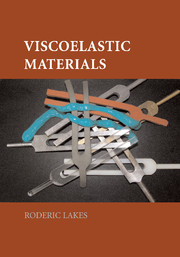Book contents
- Frontmatter
- Contents
- Preface
- 1 Introduction: Phenomena
- 2 Constitutive Relations
- 3 Dynamic Behavior
- 4 Conceptual Structure of Linear Viscoelasticity
- 5 Viscoelastic Stress and Deformation Analysis
- 6 Experimental Methods
- 7 Viscoelastic Properties of Materials
- 8 Causal Mechanisms
- 9 Viscoelastic Composite Materials
- 10 Applications and Case Studies
- A Appendix
- B Symbols
- Index
7 - Viscoelastic Properties of Materials
Published online by Cambridge University Press: 21 January 2010
- Frontmatter
- Contents
- Preface
- 1 Introduction: Phenomena
- 2 Constitutive Relations
- 3 Dynamic Behavior
- 4 Conceptual Structure of Linear Viscoelasticity
- 5 Viscoelastic Stress and Deformation Analysis
- 6 Experimental Methods
- 7 Viscoelastic Properties of Materials
- 8 Causal Mechanisms
- 9 Viscoelastic Composite Materials
- 10 Applications and Case Studies
- A Appendix
- B Symbols
- Index
Summary
Introduction
Rationale
The purpose of Chapter 7 is to present the viscoelastic behavior of representative real materials so that the reader can gain a sense of orders of magnitude of the effects. Engineers and scientists who deal with elastic behavior of materials are aware of the moduli of various common materials. Similarly, knowledge of the viscoelastic properties of particular materials is essential to rationally apply them. Further examples, with analysis of the physical causes of the viscoelasticity, are provided in Chapter 8. Materials presented here are classified as polymers, metals, ceramics, biological composites and synthetic composites (Chapter 9). In a survey, damping properties of metals, ceramics, and metal matrix composites are compared [1]. Structural metals tend to be low damping, with tan? on the order of 10−3 or less. Experimental results for the same material can differ substantially depending on purity and permanent deformation. Most ceramics also exhibit low damping at ambient temperature, but some exhibit modest damping at elevated temperature.
Overview: Some Common Materials
An overview of modulus and damping of selected classes of materials at small strain is shown in Figure 7.1. At high strain amplitude, some metals exhibit higher damping [2] in such maps.
The loss tangents of some well-known materials at various temperatures and frequencies are presented in Table 7.1. Most of the data are at room temperature, denoted rt in Table 7.1 except as noted, and at audio or subaudio frequencies.
- Type
- Chapter
- Information
- Viscoelastic Materials , pp. 207 - 270Publisher: Cambridge University PressPrint publication year: 2009



